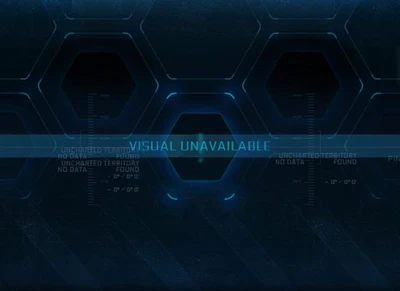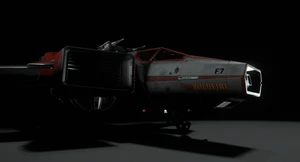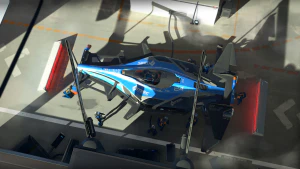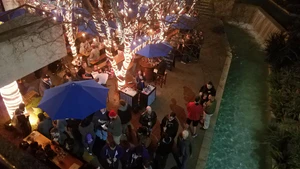Greetings Citizens,
Welcome to 2017 (or should we say 2947?) Since our last report, we’ve published a major patch (Star Citizen Alpha 2.6 with Star Marine) and have continued to make great progress towards our next updates. The launch of Star Marine was a major milestone for Star Citizen, and thanks to our dedicated community we have plenty of feedback on the FPS updates to work from. Before we move on to 2.6.1 (which is now available for testing on the PTU!) and beyond, however, let’s take a look back at the month that was January 2017 in Star Citizen’s development.
CIG LOS ANGELES
Engineerings
A new year marked by new challenges, new ideas and a whole lot of progress. We have been hard at work on our modular character customization screen, a system built on the item framework which will let players equip their characters however they choose. In addition, the LA Engineering team spent January making real progress towards the core systems that will allow us to have solar system sized maps and all the complicated components that come with it. To enable this, we had to reimagine entities including fundamental components such as lights, continue work on an intelligent radar system, and revisit how we build level hierarchies. It’s still some ways off, but we can see the principles in practice. January also saw the first technical application of node-based controller managers – this system opens the door to improved networking of item components and is the first real step towards multi-crew ship gameplay. Not flashy enough? How about explosions! We added a new damage controller that will bring things like explosive props and destroyable objects to the Item System framework soon.
Tech Design
<embedvideo service="vimeo">203375658}}
This month our Tech Designers have been hard at work on new ships, Item 2.0 support, and prototyping. As for ships, the Buccaneer and Cutlass Black have hit the greybox phase. The Aurora update is going smoothly and really looking good. Calix prototyped how players could interact with the world and items, while Kirk did some work with our studios across the pond on general ship balance, in-game pricing, and underlining systems.
Art
<embedvideo service="vimeo">203375571}}
The LA Ship Art team of Elwin Bachiller, Daniel Kamentsky and Byungjin Hyun dove right into the Drake Buccaneer (which has wrapped up in Greybox Art and moved onto Final Art) as well as a big update to the RSI Aurora. On the Concept Art side, in addition to supporting the Drake Buccaneer, Justin Wentz has been very busy creating concept art for a new Anvil ship.
This month, the Character Art team created new armor for the Persistent Universe. Most notably, the Explorer Suit, which will be used for (you guessed it!) exploring our vast universe! Another new addition is the Heavy Marine armor, which will be available soon in Star Marine. We’ve also continued working on creating more clothes for our shops and building outfits for new NPCs that will soon be seen on our various planets.
Tech Content
The Technical Content Team consists of two teams: Technical Art and Technical Animation. Technical Content is a global team with staff in all studios performing various roles.
Sean Tracy has spent the last month roadmapping for the rest of the year, working with 3lateral and other outsourcers on some R+D projects that will be revealed soon, as well as training and supporting the Technical Art and Technical Animation teams.
<embedvideo service="vimeo">203488721}}
On the Technical Art front, Atri Dave has been working with our FPS weapon team to optimize weapons, ensure grips are universal (to males and females) as well as doing some R+D with our animation programmers for a more advanced version of foot anchoring that adapts leg IK and ground alignment based on whether characters are on their heels or on the balls of their feet. Robert Dickerson has been building up a Substance Painter pipeline for the various content teams. Alex Remotti recently joined the team and within his first couple weeks has already made an enormous impact by taking ownership over the procedurally generated environments for planets, space stations and other objects in the universe. He’s already integrated the initial system into the planet editor which allows us to spawn outposts/buildings using the splatter maps from the ecosystems. Matthew Intrieri and Patrick Salerno have been making important updates to systems and art for the Super Hornet, Mustang and many other ships, as well as planning out the rest of the year in terms of “paying off” some tech debt that’s accrued on some of the older ships. Forrest Stephan has been working on S42 features as well as reviewing props and weapons for performance optimizations.
On the Technical Animation side, it’s been no less busy! Matthias Jaeger has been working on improving and implementing tools improvements for animators. These include space switching (IK/FK switching tools), prop rigging, health tests, bone influence reduction tools, and more. Rob Howes, the lead technical animator in the department, has been busy supporting cinematics and animation whilst leading the technical animation team. He’s prepared a roadmap for the rest of the year as well as doing R+D on distributed batching solutions for animation builds. Further he’s continued to iterate with animation on some issues surrounding using a separate female skeleton. Vineet Chander has done massive batches of updates to our facial and head assets, of which there are over 120! Sometimes relatively minor issues are discovered, for example the eyelids for most faces were a bit “sleepy” looking and he’s made changes so that this is longer the case. Adam Sirrelle has developed some important tools including automated LOD creation of the facial assets. Additionally, Adam has created an extra tool for the developers that allow them to much more easily manage the creation of DBA’s (Database of Animations) which are massively optimized containers for animation data. John Riggs is working on updates to the female rig, updates to the hands for better gripping of weapons, and rolling out some skinning tools for the rest of the team. Gaige Hallman has done the lion’s share of work when it comes to zoning and ensuring the modularity of the characters and the skinning that goes with that, while also working on zone culling and difficult aspect of modularity that occur around the neck and head of characters. Mark McCall is Tech Content’s resident bugsmashing ninja. While sometimes spending weeks fixing bug after bug, Mark still manages to enact major changes, such as unifying the data structure for eyes and teeth on characters as well as creating tools surrounding hair/scalp rigging. Last but not least, Erik Link has implemented facial idles on the pilots for 2.6.1 and chases up animators and content creators when there is asset build errors. He’s been instrumental in getting our asset build errors down to 0 for 2.6.0
Narrative
The Narrative team has been continuing to meet with designers at the various studios to chip away at narrative needs for 3.0, like fleshing out the mission stories we’ll be able to generate for players and looking at the various storytelling possibilities for the various environments. We’ve also embarked on a significant task of starting to build a database of text needs for Squadron 42 which will outline any terminals, Galactapedia entries, etc. that need to be in-game. There have been a handful of documents written up for additional set dressing for the levels of Star Marine; fun little ways to make Echo 11 more period-accurate or OP Station Demien reflective of the massacre that the level is attempting to recreate. Those conversations with art and design have led to the creation of a multi-page document on Snacks!
We’ve also been having weekly discussions with Britton, our esteemed xenolinguist, who’s continuing to build out the Xi’an language. These conversations have led to some deeper dives into the Xi’an society, so hopefully we’ll be able to reveal some of that to you soon.
Quality Assurance
LA QA spent most of the month aiding the LA Engineering and Tech Content teams conducting sweeps on the new frontend, ship self-destruction, damage states, missile functionality and recent changes to the character loadouts, as well as early iterations of Item 2.0. In addition, the team aided the Community team in capturing in-game footage for a number of segments, and also set up a Let’s Talk About thread to gather feedback on the Mustang series of ships.
CIG AUSTIN
Design

The majority of the ATX Design Team’s time the past couple months has been spent defining details for PU “Shop Archetypes” (some examples include Clothing Shop, Bar, Security Kiosk, Hospital, etc.) and creating design documents outlining details that are specific to each archetype. Each type of shop will have universal requirements that will apply across every shop of a specific type and this will help us save time in the long run when we then drill down into specific shop locations for upcoming landing zones and space stations. For example, every clothing shop is going to have clothing racks, mannequins, and stands to showcase the shop inventory and each display needs to follow a specific metric.
We’ve also been busy building the pillars of what will become our first iteration of the PU Economy by establishing various details concerning in-game commodity types, trade routes within the Stanton System, and white/black markets.
Lastly, we got final approval on the GDD for the “Shopping Kiosk” feature and have broken down high level design requirements for UI Team and Game Code Team. This has been a long-gestating feature so we’re happy to take it into the next stage of development.
Art
<embedvideo service="vimeo">203375167}}
Lighting Artist Emre Switzer wrapped up his work on lighting the Star Marine maps for 2.6.0 release and has now turned his attention to supporting Squadron 42 in lighting some of their environments.
Chris Smith and Josh Coons continue to make progress on their respective ships. Josh is in full swing on the Greybox Phase for the new Cutlass Black. Chris finished up his updates on the Super Hornet and has now turned his attention to a fantastic new vehicle that we’re super excited to be working on.
Animation
<embedvideo service="vimeo">203375410}}
Bryan Brewer and the PU Animation Team continue to make progress on Usable Interaction Animations to support Squadron 42. Most recently we’ve gotten Pushups, Stretches, Leaning on a Table (various angles), and female versions of all the work zone animations complete. We’ve also done a polish pass over some of the Usables to make them acceptable for use by the player in first-person.
Jay Brushwood and the Ship Animation Team have completed their work on the ship enter/exit combat speed animations. They are currently in review with Animation Director Steve Bender and we’re awaiting final sign off. While we wait, we have turned our attention to implementing animations on upcoming ships such as the Prospector and the Buccaneer.
Backend Services
The Backend Team has been hard at work on a massive project to refactor our entire backend infrastructure to a new architecture we’re calling Diffusion. Diffusion will be a truly cloud-oriented service architecture that will help improve high scalability and availability for our services. It will be powered by a top level “coordination” layer written in a proprietary language developed by our Lead Server Engineer, Jason Ely.
In addition to developing Diffusion, the Backend Team has been supporting UI Team in implementing the new in-game Leaderboards.
Quality Assurance
In January, QA began immediately fielding test requests from development which included network message queue, serialized variables, particle preloading, megamap testing and AI balance tests. QA also very much focused on reporting issues with the Game-Dev stream to ensure it is stable so that Squadron 42 and 3.0 development may continue unabated. Some other things on QA’s plate for January were training new specialists, updating internal documentation, QA tools development and new hire interviews.
Player Relations
January wrapped up a very busy period for the Player Relations team. We worked over the holiday period to make sure that we kept up with our backers’ support urgent requests, and used much of the month to catch up on the rest. To put in perspective, we were not caught up until April of last year from the busy holiday period… this year we’ve accomplished that in January!
Part of this is due to bridging our US and UK teams together, which will ultimately result in faster response times and more visibility to players. A big part of this involves Spectrum, which we will be excited to roll out to you on the main site soon. We really think you will love the entire rework of our forums and chat systems, and we think you will really appreciate our plans for building a better presence with you in chat and on the forums.
IT/Operations
It’s the beginning of the year so IT gets busy with a great deal of internal housekeeping chores like inventories, license renewals, and general cleanup and organizational tasks. One of our larger projects has been focused on expanding the bandwidth between offices to keep up with our increasing daily file transfer and build replication load. We’re also working closely with the DevOps team to supply hardware and infrastructure to support the growth of the build system as well as the continued work on the patch reduction project.
LiveOps/DevOps
The team has been working hard on multi-region support, the bulk of our efforts going toward the network and server side of our services. We are very happy to report that this work will pay dividends very soon in game and there will be more detailed information on this soon as well. We’ve also been working on our internal tools including the build system, all of which share the same goals of performance and stability improvements while keeping costs down.
FOUNDRY 42 UK
Graphics
The Graphics Team has been predominantly focusing on various lighting improvements such as shadow quality and performance within interiors. The GPU cube-map capturing is almost complete and we’re starting to write systems that maximize this tech so we can achieve truly dynamic lighting on planets and space stations. Considering how so much of our concept art makes heavy use of rectangular lights, we’ve started work on area lights. While this may sound simple, area lights are actually an active area of research for many game studios and are incredibly difficult to get right (both in terms of looks and performance). Lastly, we’re in the early stages of planning for a new and vastly more efficient particle system that eventually will replace the current one.
Programming
In the ongoing release work, we’ve been getting the leaderboards in and the new “Mega Map” implemented. Under the hood on the network side will be the proper networked serialised variables and the message queue rewrite. Other general work includes the FPS actor code refactor to make it more reliable and robust, the mission system, item pickup and put down improvements, and 3D minimap, amongst other things.
VFX
Over this past month, we’ve been doing some internal data clean-up using the Asset Manager, which culls and consolidates particle/material texture libraries, working on improving particle streaming to allow for better dynamic loading (basically freeing up memory resources) and pipeline documentation updates. There have also been high level key feature planning breakdowns of key features like Atmospheric Flight Model Effects (AFFX) such as engine trails, contrails, entry/exit and Screen-Based Area-of-Interest which will trigger screen-based effects based on camera speed and/or proximity to a specified area. Plus, we’ve been experimenting with new assets to blow stuff up.
Quality Assurance
The QA team has hardly let up this New Year. We’ve been continuing on Squadron 42 testing, extensively testing weapon balance changes and Star Marine bug fixes. We launched an investigation into the prevalent lag issue during Last Stand battles on Echo 11 and held a feedback session about gamepad controls. Most exciting though has been the first steps into the new “Mega Map.”
As always big thanks to all the backers, especially the Evocati and those who frequent the PTU. Your help is always invaluable and very much appreciated!
Art
We kicked off the new year by putting some new to be announced ships into concept and we are about to wrap up on a new Anvil design.
In other ship news, the Reclaimer is already deep into production with dedicated teams focusing on the exterior and interior. On the outside, the exterior mesh has gone through a cleanup pass and work has started on shaders. External parts such as thrusters are also close to complete. On the interior, a modular kit has been assembled for the habitation areas and the first room is nearing completion.
The Prospector team has been polishing the main LOD geometry for both the interior and exterior while cleaning up various sections to pass along to the other teams, so they can begin making it flight ready.
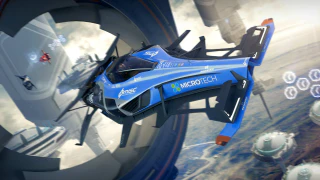
Work’s also moving forward on the MISC Razor. The artists have been adapting the concept mesh to work within the constraints set by animation which has resulted in a much sleeker more technical design whilst trying to maintain the key design elements of the original concept- the aggressive ‘Formula 1’ feel.
Onto some big news, the team’s been doing a technical and sanity pass over the S42 interior sections. Tackling collision and LODs have been the primary focus to make sure it’s in a workable state for the designers. During this review, we’re going over various elements: cleaning up and polishing pieces, refining and adding further details that we felt was lacking, and making changes to meshes that needed it. We also spent some time going over the materials, making adjustments and improvements where possible and adding blends to the primary materials of the ship.
Our props team continued working on the medium ship components and dressing sets such as tools, medical props and some assets needed for the ship interiors for S42.
Destructible props were introduced in 2.6.0 which meant we needed to create destroyed versions of a chunk of assets. This was the first iteration so was kept to the more obvious assets. Moving forward, destruction will be seen on a much larger scale and include a wider variety of prop types.
For our environments, we left some of the team polishing the 2.6.0 levels in preparation for the 2.6.1 release. This included adding more narrative assets that add a bit more history and character to the levels.
On the SQ42 front, the Shubin base is having a major push visually at the moment, since it’s a massive part of the story, we’re making sure it’s the hero it deserves to be.
We are also allocating more resource to work on the growing universe. Soon we’ll have four concept artists working out moons, nebulas and space stations, no small task! Work has begun on the first three surface outposts. These modular asset sets can be configured in multiple ways to give variation to the smaller settlements that will be scattered across the planet surfaces.
We’re looking at improving our planet’s material systems to give a better overall read all the way from space down to a meter-scale surface area. We’re doing a lot of R&D into how we dynamically and realistically scatter assets (rocks, vegetation etc.) onto the surface of a planet in a way that retains our visual fidelity and realism goals.
Conversely, we are spending some R&D time into what we want to achieve visually from space! Despite being composed of nothing, it’s very surprising how much there is to test and discuss with how we want the void between stars to feel and change as the player makes his way around a system.
Audio
Like many of the departments, the Audio used the New Year as an opportunity to go back and do some housecleaning. We reviewed all the ships to make sure that the audio for the older ships are up to the standard of the newer ships, cleaned up some bug fixes/polish for the upcoming 2.6.1 release and continued to support the community team and work on promotional materials.
On a technical front, we’ve also continued to revise and improve our dialogue pipeline and audio propagation system. A first pass at a Mix System was completed and we’re thrilled to announce that S42 will have a full music logic set in place and we’ve continued working on building ambience for some of the locations for the single player. There have been multiple improvements implemented in Star Marine from weapon sounds to dialogue which you will be able to hear soon.
UI
This month, the UI team has been primarily focused on improving and expanding the new front-end that was released in 2.6 with in-game leaderboards and a new pause menu, as well as performing various bug fixes.
We have also begun planning and scheduling for large scale UI features that we’d like to include in upcoming releases. For instance, we have been working closely with design in order to define the user-experience for purchasing & selling through the kiosk interfaces.
Animation
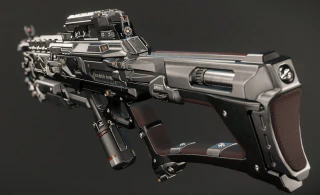
The animation team has expanded this month. We’re very excited to welcome two new additions to the team and are ready to drop them in the deep end. We’ve gotten some fantastic feedback on 2.6 and have set to bug fixing and improving animations for the next patch. We’ve been improving fps assets across the board and making grenade throws more responsive.
In other ongoing tasks, we’ve made improvements on weapon animations, specifically reload animations and have begun to previz and iterate on feedback for new weapons coming down the pipeline. We’ve also been making progress on improving prone locomotion assets and providing assistance to the ATX PU team to get female mocap data implemented to the usable animations for Subsumption.
Design
The S42 Design team have been preparing for the incoming new Mission System that will replace large elements of the levels that had previously been implemented with Flowgraph. It will be a far more robust system for us that will limit any possible inconsistencies with designer setup. Also, as the Object Container Streaming System progresses, we are making sure that we maximise performance by splitting up the other chapters in the game into logical object containers.
The Live team have been very busy with bug fixes and implementing a scoring rebalance for Arena Commander and Star Marine. There have also been some AI improvements for Space Flight that have been implemented and continued work on detailing the Stanton map.
The Tech team are still very busy moving ships functionality into the new Item 2.0 system in preparation for a whole host of new gameplay opportunities.
The Systems Designers have been working on adding a lot more detail to the framework of the multi-crew Seat Actions in preparation for meeting with Chris in early Feb.
FOUNDRY 42 DE
AI
For AI, 2017 started with a one-week summit in the Los Angeles studio: we went through several topics that will be important for the improvements we want to do during the new year.
In the past few weeks, we’ve been getting the core functionalities of Subsumption into the Subsumption Mission System. The goal is to give designers the tools to create a larger variety of missions as quickly as possible. To achieve that, we have been implementing a way to reuse a piece of logic through the creation of “functions.” Functions can either have a “global” or “local” (to one activity or one mission) scope and they dynamically generate a task that can be used as a regular Subsumption task.
Going through the Crusader missions and rebuilding them in this new tool allowed us to identify and reorganize the functionalities that are currently required by designers to create their own logic. Just to give you some idea of the work done, here’s a description of some of the functionalities we recently worked on:
- Added a task to enable/disable markers in the environment for the mission owner
- Ability to spawn dynamic Action Areas in the environment and react to the events they generate
- Support for the InteractiveObjects to correctly handle the callbacks sent to the mission system
- Added support for tracking dynamic spawning of the entity and the ownership of the requests. This will allow us to allow entities to despawn only other entities they owned. Also it makes much easier for a mission to clean up the resources created.
- We improved the debug draw functionalities of Subsumption and the mission system and also added network support for the mission log (This is a sort of personal storage for the logs of each mission)
- We created a SimpleAudioComponent that allows the mission system to communicate directly with the mission owner’s client
- We added a functionality to allow the spawning system to filter and limit the spawning of entities to specified Action Areas
- We added the basic support to spawn Subsumption Platform/Layers (We will give you more details about this in the upcoming weeks)
For the character AI, we have continued the work for finalizing the changes in the Cover System and the Posture Manager to allow those systems data to be correctly exported inside Object Containers and used at runtime in non z-up environment. We’ve also been prototyping AI Characters reacting to players bumping into them by making sure that the movement code understands when progress over the movement cannot be achieved due to the player interrupting the character movement. We also continued our refactoring of the spaceships flight control, we are moving towards removing some layers of complexity and make more direct use of the IFCS from the AI perspective. This will allow us to benefit from any improvements made for the player in a much more straightforward way.
Quality Assurance
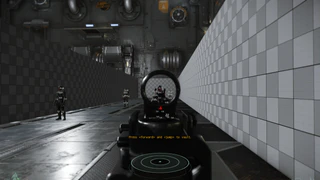
DE QA like to refer to the month of January as the “catch-up” month and used this time to tackle various test requests that required additional information as well as clearing out any Editor regression from Game-Dev that at the time was of a lower priority than regression in 2.6. We also spent a majority of January revamping our existing Editor checklists and documentation, as well as providing additional Editor training for testers in our UK office.
Additionally, we reviewed Star Marine feedback from our community and acted upon this feedback with test cases to provide additional information for our design team. The QA team also decided to review our existing sanity checks with Production and decide which were still useful to the team and which checks could be removed completely. We also used this opportunity to go over new bug tracking procedures with Production, so that we were all on the same page regarding labels that are used in our daily QA filters. Ivo Herzeg also kept us busy with changes made to the 1st person camera system, in which we were required to test all game modes. DE QA closed out the month with testing for Chris Bolte in order to track down a ZoneSystem crash that was plaguing our community in the latest 2.6 live release. We managed to finally reproduce this issue with 9 testers total (2 from DE and 7 from UK), which allowed Chris to narrow it down to being a logic error. Additional debugging was added to our Game-Dev branch and we will be attempting another playtest to reproduce this issue on Game-Dev, so that it can be finally fixed once and for all.
Cinematics
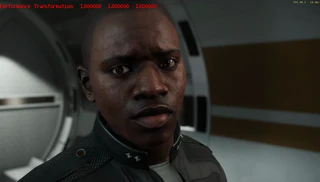
Part of the Cinematics team is currently in a sprint to push towards a “final” look and feel for the conversation system that is used for talks between the player and NPCs (which the S42 campaign features a lot of).
This includes topics like:
- UI text placement and animation for dialogue choices
- Solving issues of: If, how and when to slow a player down running towards an NPC.
- How to make “gentle” collisions between physics capsules when the player violates personal space by getting too close.
- How to adjust recorded performances and manipulate the actor’s Look or even Body pose to match for a changing player position. (we call that performance transformation)
- Dynamic camera effects that kick in when the conversation is initialized both in a change of FOV and Depth of Field blur increasing.
We want our conversations to feel “filmic” while still allowing the player freedom. Invoking a “cinematic” feel first and foremost means changing the lens to values that are more akin to how a film camera would depict a character. The engines FOV traditionally is calculated with a vertical FOV value. The current in-game on-foot FOV is at 55 which is equivalent to an extreme wide angle lens of approximately ~13mm (using 35mm film equivalent ARRI master prime lenses as a comparison). That kind of lens is bordering on fisheye lens territory. If the player gets close to a character using this kind of FOV it distorts faces, so what we are doing is gradually changing the FOV over a certain time down to 30 which is equivalent to a ~25mm wide angle portrait lens. We are finding this is a nice compromise of the faces revealing all of the awesome scanned detail by appearing big on screen while still allowing for a sense of orientation in regards to the background (if player decides to move during a conversation).
Engine
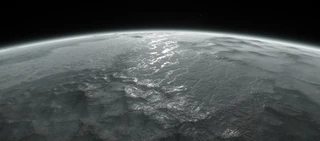
Work has started on our internal Solar system editor (SolEd), with a “top/down” universe view. We found that a custom editor extension became necessary due the massive scale of our solar system. It’s now possible to drag and drop Object Containers containing planets, space station etc., and see in real-time planets and objects moving while zooming all the way from a galaxy view down to grains of dirt on a planet. Ongoing work continues on procedural objects distribution on planets, scattering of large rocks on moon’s surfaces, initial passes of objects and vegetation blending with the planet terrain surface, improvements on particles distribution and vegetation / wind on a planetary scale. Initial passes on spawning Object Containers like small outposts on the planet surface, and initial work on adapting them to the environment with adjusting their parts to the terrain and blending the colors to make them more visually integrated like they were actually placed by Humans in the environment wrapped this month. And additional improvements have been added for large scale planet rendering like glossy surfaces and more artists controlled parameters.
There also has been effort towards reintroducing static code analysis as a mandatory part of the TryBuild system, Zone system fixes / optimizations, ongoing work on the new pak system for the patcher updates, and fixes and support for 2.6.1.
Tech Art
<embedvideo service="vimeo">203375490}}
The Technical artists in Frankfurt have been busy supporting FPS features and weapons for 2.6. They improved the weapon IK grip setup, now almost all weapons are using the runtime IK grip which helps us to change left hand poses per weapon while keeping base animation the same. They also created new cVars for previsualizing and testing new weapons in the engine with all their functionality. On the Engine side, we are participating in R&D efforts to improve foot planting in game and we’ve already started seeing good results.
Design
The Level Design team in Frankfurt is prototyping the modularity systems for Satellites, Surface Outposts and Space Station Interiors which is almost complete. Currently, the Environment Art team is providing us with greybox versions of the components that we will use to assemble the modular locations.
With our locations, the main goal is always to use them to complement upcoming systems, provide a base for future game play, as well as add to the feeling of a living, functional and realistic universe. This doesn’t always mean that the gameplay related to a location will be available when we release the station template, rather we try to ensure that once said system/gameplay becomes available we already have the location required. For this reason (and as seen on previous ATVs) we are continuing our work on the Truck Stop, Refinery and Cargo Station, the first design phase of these is complete and they have now been handed over to the Environment Art team.
The System Design guys have been refactoring our usable system to allow both AI and players to make use of the same objects at the same time (such as AI and player sitting at the same table, interacting with each other). We’re also adding support for multiple actions to be performed while inside a usable and smoothly transitioning between these actions (character sitting at a table can be eating, talking, scratching his nose, sleeping with his head on the table etc.)
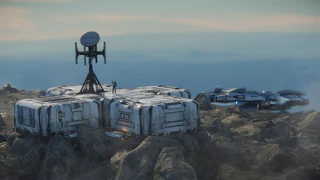
The Oxygen, Breathing & Stamina systems have started being implemented and soon we will have players begin to carry their own oxygen supplies or risk turning blue in the face. The system should handle everything from how the oxygen tank delivers breathable air to the helmet, to how the player breathes said air and how his body converts that into actual usable stamina. At the same time, all actions are being converted to consume this stamina, so you will want to keep your character supplied with oxygen if you want them to be capable of performing various actions.
Landing and Take-off systems are also going into implementation mode as we are unifying Squadron 42 and PU mechanics. The system should easily handle everything from the more basic taking off in the PU to the fully cinematic experiences needed in S42. Basically we’re implementing an air traffic control system that allows players to queue for landing permissions and makes sure that people don’t block landing sites for everyone else.
Small additions were also made to the Mercenary and Bounty Hunter career designs and the systems needed for these. Customs are also receiving some design love as we are start to gate what the player can bring in legally and how smuggling things in high security areas works.
VFX
The Frankfurt VFX team has been continuing to work with the programming team on the tools required to spawn various particles across the planets. One of the more recent additions has been the implementation of planetary wind. Due to the spherical nature of the planets, the wind had to be completely rewritten to work correctly across the surface of a planet. This will help to make the environments feel more alive, from blowing around smoke and dust to rustling the leaves on the vegetation.
Environmental Art
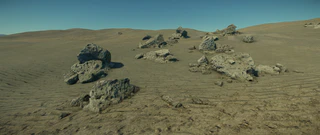
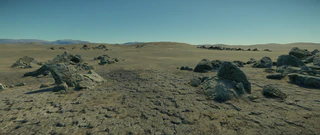
The environment team here in Frankfurt has grown again with two new people joining the team this month. With the increased amount of environment artists, we’re able to put even more effort into our procedural planet tech. We’ve been recently building great looking assets for individual moons, as well as refining our procedural tech and tools for moons, full planets, and full systems. One key element of the planetary tech that we’ve been focusing on is the procedural scattering system, which will allow us to procedurally scatter rocks, plants, trees and other elements across planets based on artist defined rules. While the tech is still in development, the first automated results are already promising and are improving every day.
TURBULENT
Spectrum Alpha
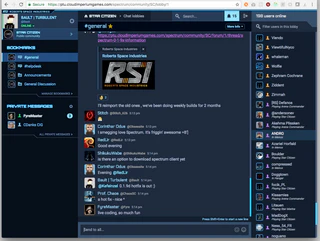
We are working hard towards Spectrum’s initial public alpha release alongside SC 2.6.1. We can’t wait for you guys to get your hands on it with your Orgs. In its first incarnation, expect the web version of public and private chat, forums, search functionality as well as member presence and a decent mobile experience.
The Evocati and volunteer testers have been invaluable in providing initial feedback and bug reports (yeah, yeah we have those too!) on the PTU since December. Our weekly build process and direct contact with users have really helped us focus on the features and bug fixes that matter the most to those who use the tools. Once it is released to live, we will be continuously working to build out and improve Spectrum with your feedback.
After the live release and stabilization phase, we plan on adding more community customization features and create dedicated mobile applications so Spectrum can follow you everywhere you go.
We will share more details about our roadmap once we get this first major release out of the way!
Sales
Coming off the holiday break, two promo competitions were introduced, a revamped Vanduul Swarm and the all new Pirate Swarm. These modes tested players’ skills to the limit and if they were able to complete all waves of the challenge, they were awarded an aggressor badge to display their accomplishment. For a limited time, these successful pilots were also given the ability to purchase the Vanduul Glaive upon completing Vanduul Swarm and the new Pirate Caterpillar upon completing the Pirate Swarm.
To close out the month, the sleek Dragonfly Posters and the comfortable Squadron 42 Hoodies were put back on the merchandise store, but get them soon before they are gone!
COMMUNITY
Broadcasts
January saw a number of changes to our community content. Around the Verse continues to be refined as we explore new ways to showcase progress without monopolizing too much of our developer’s time. Our January Subscriber’s Town Hall featured Chris Roberts, Erin Roberts, Tony Zurovec and Todd Papy. It was a rare opportunity to have all these important leads sitting and chatting in the same place. We also launched two new shows. Star Citizen Happy Hour is a way to involve fan broadcasters and CIG developers in a gameplay session and casual hangout with the community. Then there’s our other new show focused on YOU. Citizens of the Stars highlights the amazing contributions you make to the Star Citizen experience. It also features ‘Quantum Questions,’ in which CIG developers answer your questions… as many as they can in two minutes! If there’s one constant in our broadcast output, it’s change. We’ll continue to iterate throughout the rest of 2017 and beyond in an effort to bring you the best and most relevant content possible.
Events
Community Managers Jared Huckaby and Tyler Witkin went to PAX South and attended the local Bar Citizen event in San Antonio. Opportunities to hang out and meet the backers are one of the best parts of our job, and the folks who turned out for this event were a stellar group, as usual. Remember that Bar Citizen events are 100% fan organized. You can see if there’s one in your area and maybe even find help planning one at the fan website barcitizen.sc.
This Week in Star Citizen
The old Community Manager’s Log and Schedule has evolved into a new, weekly front page post called This Week in Star Citizen. The post highlights what’s happening each week, and provides a look at some of the content you may have missed from the Star Citizen community.
Finally, testing continues on Spectrum, the upcoming replacement to our current forum and chat systems. You can join the testing now at ptu.cloudimperiumgames.com/spectrum with new builds going out each week. We’re excited to roll out the first official iteration of Spectrum in the near future. We’ll continue to add intended features and iterate on it based on your feedback throughout the remainder of the year.
